Relationships between respiration and susceptibility to azole antifungals in Candida glabrata
- PMID: 12604511
- PMCID: PMC149308
- DOI: 10.1128/AAC.47.3.847-853.2003
Relationships between respiration and susceptibility to azole antifungals in Candida glabrata
Abstract
Over the past two decades, the incidence of infections due to Candida glabrata, a yeast with intrinsic low susceptibility to azole antifungals, has increased markedly. Respiratory deficiency due to mutations in mitochondrial DNA (mtDNA) associated with resistance to azoles frequently occurs in vitro in this species. In order to specify the relationships between respiration and azole susceptibility, the effects of respiratory chain inhibitors on a wild-type isolate of C. glabrata were evaluated. Respiration of blastoconidia was immediately blocked after extemporaneous addition of potassium cyanide, whereas a 4-h preincubation was required for sodium azide. Antifungal susceptibility determined by a disk diffusion method on Casitone agar containing sodium azide showed a significant decrease in the susceptibility to azoles. Biweekly subculturing on Casitone agar supplemented with sodium azide was therefore performed. This resulted after 40 passages in the isolation of a respiration-deficient mutant, as suggested by its lack of growth on glycerol-containing agar. This respiratory deficiency was confirmed by flow cytometric analysis of blastoconidia stained with rhodamine 123 and by oxygraphy. Moreover, transmission electron microscopy and restriction endonuclease analysis of the mtDNA of mutant cells demonstrated the mitochondrial origin of the respiratory deficiency. Finally, this mutant exhibited cross-resistance to all the azoles tested. In conclusion, blockage of respiration in C. glabrata induces decreased susceptibility to azoles, culminating in azole resistance due to the deletion of mtDNA. This mechanism could explain the induction of petite mutations by azole antifungals which have been demonstrated to act directly on the mitochondrial respiratory chain.
Figures
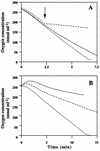
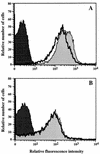

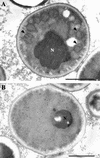
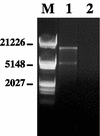
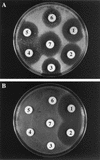
References
-
- Aoki, S., and S. Ito-Kuwa. 1987. Induction of petite mutation with acriflavine and elevated temperature in Candida albicans. J. Med. Vet. Mycol. 25:269-277. - PubMed
-
- Baddley, J. W., A. M. Smith, S. A. Moser, and P. G. Pappas. 2001. Trends in frequency and susceptibilities of Candida glabrata bloodstream isolates at a university hospital. Diagn. Microbiol. Infect. Dis. 39:199-201. - PubMed
-
- Beck-Sague, C. M., and W. R. Jarvis. 1993. Secular trends in the epidemiology of nosocomial fungal infections in the United States, 1980-1990. National Nosocomial Infections Surveillance System. J. Infect. Dis. 167:1247-1251. - PubMed
-
- Bodey, G. P., M. Mardani, H. A. Hanna, M. Boktour, J. Abbas, E. Girgawy, R. Y. Hachem, D. P. Kontoyiannis, and I. I. Raad. 2002. The epidemiology of Candida glabrata and Candida albicans fungemia in immunocompromised patients with cancer. Am. J. Med. 112:380-385. - PubMed
-
- Bouchara, J. P., R. Zouhair, S. Le Boudouil, G. Renier, R. Filmon, D. Chabasse, J. N. Hallet, and A. Defontaine. 2000. In vivo selection of an azole-resistant petite mutant of Candida glabrata. J. Med. Microbiol. 49:977-984. - PubMed
MeSH terms
Substances
LinkOut - more resources
Full Text Sources
Miscellaneous

